The week at a glance
- American Coot still in Co Mayo
- Pied-billed Grebe in Co Cork
- House Crow still in Co Cork
The quality rarities of the week had a decidedly Irish feel. Having been present for a while now, the American Coot, which remained at Termoncarragh Loch (Co Mayo) to at least 11th, may have been upstaged this week by the appearance of another Pied-billed Grebe. This one turned up on Little Island (Co Cork) on 11th–12th. This is actually the third (or fourth) for Cork, following one in 2000 and a bird in 1997 that returned in 1998.
Pied-billed Grebe, Little Island, Co Cork (Film: ronanmclaughlin1).
The only other mega was the House Crow, which was in Cobh (Co Cork) to at least 11th.
The only Snow Goose reported this week was one of perhaps dubious origin, with Greylag Geese at Broom Gravel Pits (Bedfordshire) on 11th. Another report actually referred to a Ross's Goose × Barnacle Goose hybrid, at Old Hall x (Essex) on 12th. There were more Ross's Geese, with one at Caerlaverock (Dumfries & Galloway) on 11th–12th and a presumed escape with Canada Geese at Kelling (Norfolk) on 9th, which may or may not be the bird seen at Langham the next day.
It must be fate, but no sooner do we upgrade the rarity status of Lesser White-fronted Goose, from rare to mega, than one is reported, from Buckenham Marshes (Norfolk) on 13th–15th. Norfolk has a fair history of feral Lesser White-fronts though, with up to three 'plastic' birds roaming the county over the last 10–20 years. Whether this bird, with Taiga Bean Geese, is the real deal may never be known. There was some suggestion that it had some hybrid features, but this has yet to be confirmed.
Mixed in with flocks of Brents, of varying belly colours, there were still several Black Brants this week. New birds reported were at Brand's Bay (Dorset) on 12th, Wexford Wildfowl Reserve (Co Wexford) on 12th, Hoo St Werburgh (Kent) on 15th and Holland Haven Country Park (Essex) on 15th. One was still wandering around Norfolk, seen at Wighton on 14th, and two remained on The Fleet to at least 11th. The Suffolk family party of Red-breasted Geese dropped to four this week, with two of unknown origin with Dark-bellied Brent Geese at Topsham (Devon) on 13th. The only other goose of interest was a Richardson's Canada Goose at Raghly (Co Sligo) on 11th–12th, then presumably the same at nearby Ballyconnell on 13th.

Black Brant, Sturt Pond, Hampshire (Photo: Richard Hopkins)
With no reports from Chew, the only Ferruginous Duck reported was an escapee, at Jubilee River Nature Reserve (Buckinghamshire) on 14th. The drake Ring-necked Duck remained at Ballyallia Lake (Co Cork) to 12th, with the only other at The Gearagh (Co Cork) on 12th. Females were still at Lough Gur (Co Limerick) to 15th and Cork City (Co Cork) to 13th. Also in Ireland, the drake Black Duck was at Achill Island (Co Mayo) on 10th.
A drake American Wigeon at Rutland Water on 9th–14th was the first in the county (or more accurately Leicestershire and Rutland) for seven years, the last also being at the same site. A couple of Lesser Scaup were still present; the female at St Mary's (Orkney) to 14th and the drake in Cardiff Bay (Glamorgan) stayed to 9th, then was seen at Cosmeston Bay Country Park on 11th. One reported from Farmoor Reservoir (Oxfordshire) on 11th was actually a well-known hybrid that resides there.
Small numbers of Green-winged Teal continued to be reported, with drakes still at Caerlaverock (Dumfries & Galloway) and Kinneil Lagoon (Forth) all week and Aberlady Bay (Lothian) to 9th. Others were at Millom (Cumbria) again on 11th (first reported on 27th November) and at Bell Harbour (Co Clare) on 11th (last reported on 20th November).

Green-winged Teal, Kinneil Lagoon, Forth (Photo: Anne Cotton)
The female Surf Scoter remained off Dawlish Warren (Devon) all week, and another was still at Aghada and Marloag Point (Co Cork) to 12th. There was also a brief fly-by bird off Rerwick Head (Orkney) on 12th, in the company of 24 Great Northern Divers and 13 Velvet Scoters. The only King Eider was the first-winter drake still at West Voe of Sumburgh (Shetland) to 12th, and after a short absence, the drake Northern Eider was reported again at Embo (Highland) on 10th.

King Eider, West Voe of Sumburgh, Mainland, Shetland (Photo: Roger Riddington)
Smew were still well represented, with birds reported from at least 45 sites, including five sites in Suffolk. Peak counts came from similar sites to previous weeks, with 11 at Fen Drayton (Cambridgeshire), 11 at Rutland Water, eight at Pitsford Reservoir (Northamptonshire) and five at Grafham Water (Cambridgeshire).
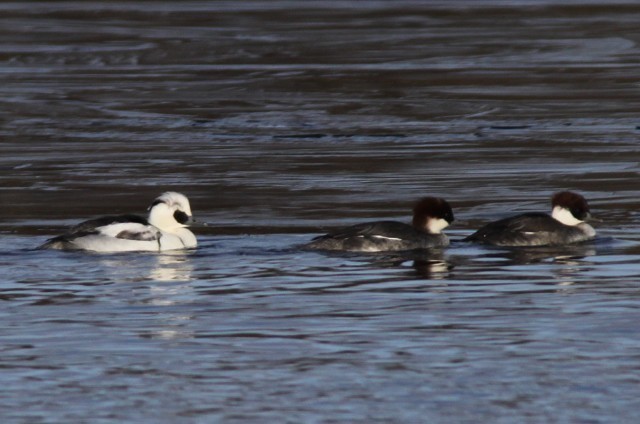
Smew, Cotswold Water Park, Gloucestershire (Photo: Jon Mercer)
Last week's small group of Balearic Shearwaters in Carbis Bay (Cornwall) bizarrely lingered, with up to 22 reported during the week. The only others were singles off St Catherine's Breakwater (Jersey) on 12th and 13th. Equally unseasonable was a lone Manx Shearwater past Flamborough Head (East Yorkshire) on 11th.
Just one Glossy Ibis remained on the Otter estuary (Dorset) this week, with one also still at Exminster (Devon) on 11th. One was also still in Glamorgan, at Monknash on 10th. One new bird was at Freeman's Marsh (Berkshire) on 9th–12th, and (ignoring an apparently unsubmitted bird over Winnersh in 2007) is only the second record for the county, following two on the River Thames in 1793.

Glossy Ibis, Freeman's Marsh, Berkshire (Photo: Andy Johnson)
There were just eight Great White Egrets reported, with birds in Cheshire, Somerset, Wiltshire, Nottinghamshire, Northamptonshire and Kent. There are now two Cattle Egrets at Grouville Marsh (Jersey), present all week, with a new bird at Milton Clevedon (Somerset) on 13th.
While it's been busy on the rarity front we haven't reported on Spoonbills, but now things have quietened down we can squeeze them back in. The only groups still around included eight at Isley Marsh (Devon) and three on the Camel estuary (Cornwall). There were then two on Green Island and Samson (Isles of Scilly), over Astbury Mere (Cheshire) and at Holes Bay (Dorset), and singles at Courtmacsherry (Co Cork), Blakeney (Norfolk) and Dinham Flats (Cornwall).

Spoonbill, Isley Marsh RSPB, Devon (Photo: Andy Seely)
For the younger generation of Sussex listers, a juvenile White-tailed Eagle at Amberley Wild Brooks (West Sussex) on 11th–12th was kind enough to stay for two days. This is the first modern-day record for Sussex, with the last being in 1929! After leaving at mid-day on 12th, the same bird was then seen over Arundel (West Sussex) 20 minutes later, over Southsea (Hampshire) an hour after that and then finally over Fareham and Titchfield Haven 30 minutes later.

White-tailed Eagle, Amberley Wild Brooks SWT, West Sussex (Photo: Daniel)
The wanderings of the south coast White-tailed Eagle. View in a larger map
In Norfolk, Rough-legged Buzzards were reported from numerous sites, with two birds roving around the Holkham/Wells/Burnham Overy/Scolt Head area all week and another at Chedgrave and Haddiscoe Marshes. Elsewhere, the long-stayer remained at South Ferriby (Lincolnshire) all week and in the west one was at Bridgend (Glamorgan) on 13th and a possible was at Connah's Quay (Clwyd) on 12th–13th. The Northern Harrier remained along the north Norfolk coast all week, becoming slightly more predictable in its habits, and there was an in intriguing report of a Lanner Falcon at Walmsley Sanctuary (Cornwall) for 30 minutes on 14th. While we're talking about raptors of unknown provenance, we should just mention the Snowy Owl that escaped from a collapsed aviary recently and was present at Houghton-le-Spring (Durham) on 9th.

Rough-legged Buzzard, South Ferriby, Lincolnshire (Photo: Graham Catley)
The Dorset Long-billed Dowitcher got itchy feet again, wandering out to Langton Herring on 9th–12th before returning 'home' to Lodmoor for the rest of the week. One rather unusual record was a Stone Curlew found dead on Holy Island (Northumberland) on 12th. This bird had originally been ringed as a chick in Breckland (Norfolk) in June this year, and this may also be the same bird seen recently on the nearby Farne Islands.
The only Grey Phalaropes were the long-stayer at Dunbar (Lothian), to 13th, and a new bird on the Thames at Grays (Essex) on 12th–15th, which may have been the same as at Rainham Marshes earlier in the month.
There were a fair few juvenile/first-winter Glaucous Gulls reported, coming from nine sites, with second-winters at Throckmorton Tip (Worcestershire) and Dosthill Lake (Warwickshire) and an adult at Lawford Heath Landfill (Warwickshire). There were more Iceland Gulls, and of more variety in age as well. Juveniles (or first-winters) were reported from nine sites, including the well-photographed bird at Lowestoft (Suffolk) and three together at Richmond Bank (Cheshire). There were then adults in Orkney, Staffordshire, Warwickshire and Cornwall, third-winters in Dumfries & Galloway, West Midlands and Staffordshire, and second-winters in West Yorkshire and Cheshire.

Glaucous Gull, Aberdeen, Aberdeenshire (Photo: Joseph Nichols)
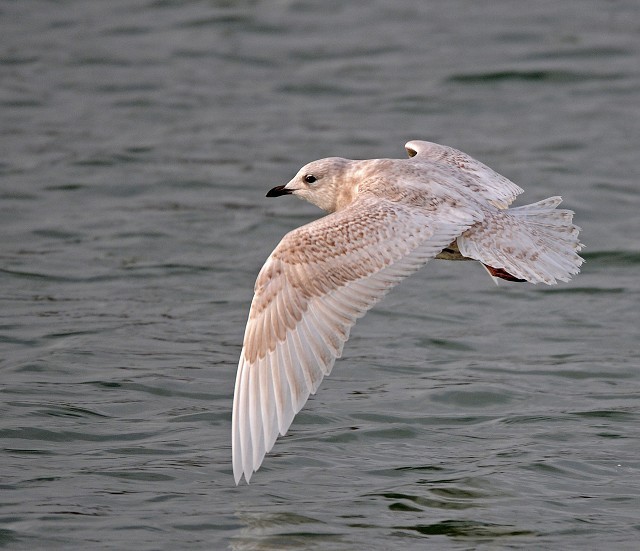
Iceland Gull, Lowestoft, Suffolk (Photo: Jon Evans)
Several of the regular Ring-billed Gulls were reported, at Gosport (Hampshire) to 12th, Nimmo's Pier (Co Galway) to 12th, Oban (Argyll) to 12th and Sands Lane Gravel Pit (West Yorkshire) and Portrush (Co Antrim) all week. The only new birds were then in Ireland, in Dublin on 9th and Cork City on 12th–13th. Also in Ireland, the Co Galway Forster's Tern was reported from Mutton Island on 12th.

Ring-billed Gull, Sands Lane GP, West Yorkshire (Photo: Chris Downes)
As expected, the flocks of Shore Larks remained, with up to 19 at Dingle Marshes (Suffolk), six at Gibraltar Point (Lincolnshire), five at John Muir Country Park (Lothian) and a five new birds at Tyninghame Bay (Lothian). With so much southward movement, we're swamped with Waxwing records now, and everyone should keep an eye out for colour-ringed birds. The map of movements we have just published is already out of date, so keep an eye out for more updates soon.

Shore Lark, Dingle Marshes SWT, Suffolk (Photo: Chris Upson)
Waxwing, Dalston, Cumbria (Film: MrDavidh49).
It was good to see one last glimmer of summer surviving, with the Hoopoe still at Longham Lakes (Dorset) until 12th. In what has been a record year for Black-throated Thrush records, there was another, unconfirmed, report this week. This was seen briefly in a garden in Old Basing (Hampshire) on 13th-14th, but field sketches of the bird later circulated didn't suggest this species; if anything it looked more like a Dusky Thrush! With records from virtually all surrounding counties, Black-throated Thrush would be a long-overdue first for Hampshire, but I'm sure many would prefer it to be a Dusky.

Hoopoe, Longham Lakes, Dorset (Photo: Richard Cox)

Mystery thrush, Old Basing, Hampshire (Courtesy of Rob Still)
There were no reports of Yellow-browed or Hume's Leaf Warblers this week, but plenty of reports of Siberian Chiffchaffs, some perhaps more reliable than others. Their identification is rarely straightforward, and we will hopefully look at this in the coming weeks. Great Grey Shrikes were back up to slightly better numbers, reported from at least 13 sites over the week. Apart from birds at Thornhill (Forth) and Bolton Abbey (North Yorkshire), all the others were in the south, including an impressive five in Hampshire. There was also another record of a 'Nordic' Jackdaw, at Shannon (Co Clare) on 15th.

Siberian Chiffchaff, Coverack, Cornwall (Photo: Steve Bury)
Debate over redpolls continued, and a mystery bird at RSPB HQ (Bedfordshire) over the last couple of weeks was possibly a Coues' Arctic Redpoll and another possible was at Holme Fen (Cambridgeshire) on 12th. Numbers of Lapland Buntings have dropped now to almost countable proportions, with birds reported from over 30 sites around the country. Most were in the south, with the only Scottish birds being three on North Uist (Outer Hebrides), and the only Irish birds being two at Tacumshin (Co Wexford). Most reports were also of singletons or small groups, with the only notable flocks being 43 at Port-Eynon Point (Glamorgan) and 31 at Breydon Water (Norfolk).
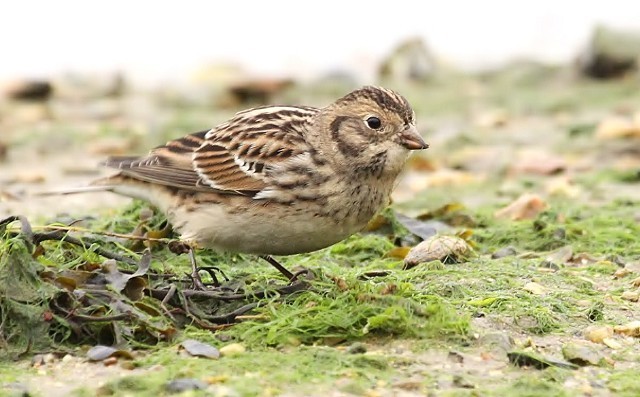
Lapland Bunting, Milford-on-Sea, Hampshire (Photo: Lee Fuller)
The Common Rosefinch continues to frequent the garden feeders at Bardsey Island (Gwynedd), present to at least 11th. I'm sure there must be more Northern Bullfinches still around, but the only record was a male still at Strumpshaw Fen (Norfolk) to 13th. For tips on identification, check Martin Garner's latest ID article in the webzine.
The possible eastern Yellow Wagtail remained at Colyford Sewage Works (Devon) all week and was trapped and ringed on 14th. Hopefully the small deposit it left in one ringer's hand will help in its identification, as will the in-hand biometrics and the fact that the bird also called while in the hand. Other migrants now wintering included two Sandwich Terns in Hampshire on 13th and Lesser Whitethroats — of unknown racial origin — in Kent on 12th and Suffolk on 15th.
Photo of the Week: 9th–15th December 2010

Short-eared Owl, Worlaby Carrs, Lincolnshire (Photo: Mark Hancox)
This week's Photo of the Week choice is unlikely to come as a surprise. Head-and-shoulders shots of Short-eared Owls are always popular because they make the most of those wonderful yellow eyes and rich facial details. Occasionally, one of these photos gets the added interest value that comes from direct eye contact or from capturing the elusive 'ears'. In Mark Hancox's outstanding close-up submitted this week, taken at Worlaby Carrs, Lincolnshire, these attributes are only the start. Added to these are a snowy backdrop, great lighting and, most of all, a perfectly positioned vole hanging from the owl's bill. Mark spent a lot of time with this wild bird and had observed it catching several voles and burying them in the snow. As reward for his patience, Mark now has a superb range of 'Shorty' images on his website, but this one definitely takes the biscuit!
Other notable photos
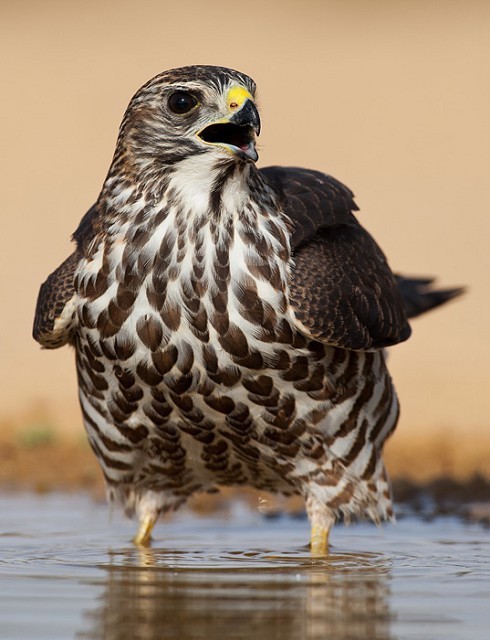
Levant Sparrowhawk, Israel (Photo: Danny Laredo)

Woodcock, Crail, Fife (Photo: John Anderson)
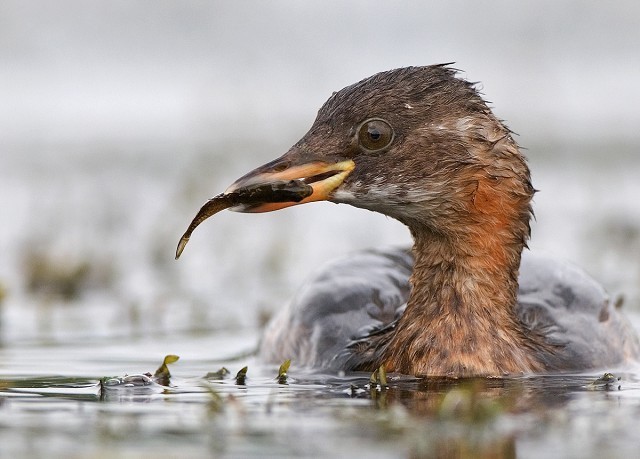
Little Grebe, Colwick CP, Nottinghamshire (Photo: Jamie MacArthur)
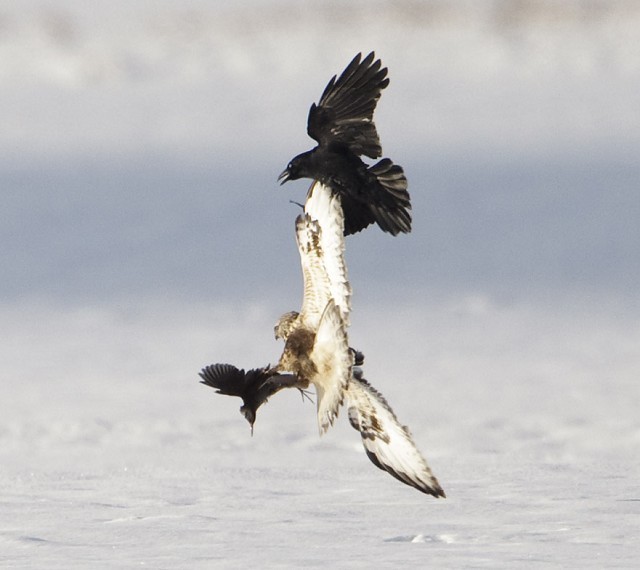
Rough-legged Buzzard, South Ferriby, Lincolnshire (Photo: Graham Catley)
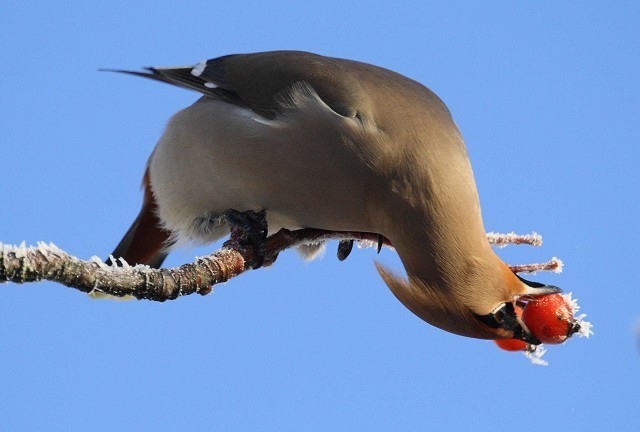
Waxwing, Partick, Clyde (Photo: Glasgowstef)

Common Kingfisher, Les Grand Pre, Guernsey (Photo: Chris Bale)

Goldeneye, Fleetwood, Lancashire (Photo: David Cookson)

Hawfinch, Germany (Photo: Siegbert Werner)

Blackcap, Alphington, Devon (Photo: Charlie Fleming)

Small Pratincole, India (Photo: Dave Williams)

Bittern, Stodmarsh NNR, Kent (Photo: Steve Ashton)

Crested Tit, undisclosed site, Highland (Photo: Marcus Conway - ebirder)

Purple Sandpiper, Lowestoft, Suffolk (Photo: Jon Evans)

Blue Tit, Spital, Cheshire (Photo: Steve Round)

Redwing, Wideopen, Northumberland (Photo: Nigel Tinlin)

Hen Harrier, Marloes, Pembrokeshire (Photo: Richard Stonier)

Dunlin, Keyhaven Harbour, Hampshire (Photo: Daniel Trim)

Teal, Minsmere RSPB, Suffolk (Photo: Carl Wright)

Reed Bunting, Pennington Flash CP, Greater Manchester (Photo: Steve Oakes, AEBS Limited)

Herring Gull, Campbeltown Loch, Argyll (Photo: Jimmy MacDonald)

